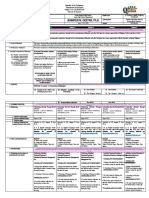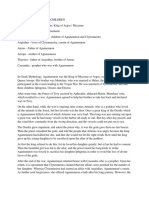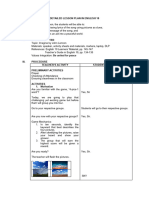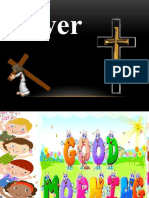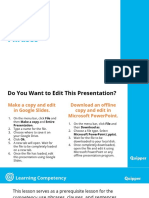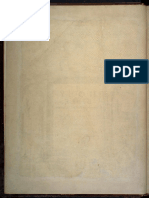Imagery and Symbolism
Uploaded by
Daphne SyImagery and Symbolism
Uploaded by
Daphne SyName: _________________________
Grade and Section: _______________
IMAGERY AND SYMBOLISM
Imagery as a literary device uses descriptive language for readers to better understand a
piece of literature. It gives us a clear picture of the world we need to imagine. Pieces of
literature may use the five senses, sight (eyes), hearing (ears), taste (tongue), touch (skin),
smell (nose) to help us understand the world that the writer created in his work.
Directions:
Give at least four instances where the following senses were used in the poem,
CAGED BIRD by Maya Angelou.
1. Sight – Ex. The sunrise in orange edged with blue, pink, purple, and red is a truly
majestic sight to behold.
_______________________________________________________________________
_________________________________________________________________________
2. Sound – Ex. The loud party in the neighborhod annoyed Rita.
_______________________________________________________________________
_________________________________________________________________________
3. Touch – With our mother’s rough hands comes a story of her love and sacrifices
for us.
_______________________________________________________________________
_________________________________________________________________________
4. Smell – His breath went totally awful after eating garlic.
_______________________________________________________________________
_________________________________________________________________________
5. Taste – Ex. Eating his favourite “ensalada” brings back a memory of his youth.
_______________________________________________________________________
_________________________________________________________________________
ACTIVITY
I. Analyze the given poem and identify the imageries and symbolism used in the poem.
Stopping by Woods on a Snowy Evening
By: Robert Frost
Whose woods these are I think I know.
His house is in the village though;
He will not see me stopping here
To watch his woods fill up with snow.
My little horse must think it queer
To stop without a farmhouse near
Between the woods and frozen lake
The darkest evening of the year.
He gives his harness bells a shake
To ask if there is some mistake.
The only other sound’s the sweep
Of easy wind and downy flake.
The woods are lovely, dark and deep,
But I have promises to keep,
And miles to go before I sleep,
And miles to go before I sleep.
Poetry Foundation for Children (2020).Stopping by Woods on a Snowy Evening.
Retrieved September 16, 2020 from
https://www.poetryfoundation.org/poems/42891/stopping-by-woods-on-a-snowy-evening
You might also like
- Noli Me Tangere and El Filibusterismo (Content, Context and Relevance)100% (1)Noli Me Tangere and El Filibusterismo (Content, Context and Relevance)6 pages
- Literary Elements in Poetry Prose and DramaNo ratings yetLiterary Elements in Poetry Prose and Drama21 pages
- Persuasive Messages.: Q2 Performance TaskNo ratings yetPersuasive Messages.: Q2 Performance Task6 pages
- Orpheus (From Ancient Greece) : by Alice LowNo ratings yetOrpheus (From Ancient Greece) : by Alice Low2 pages
- DLL English 10 Q1 - Module 1 - Lesson 2 - Reflection, The Gorgon's HeadNo ratings yetDLL English 10 Q1 - Module 1 - Lesson 2 - Reflection, The Gorgon's Head9 pages
- ACTIVITY NO. 1 (Third Grading) English Grade 8 Poetry - PoeticsNo ratings yetACTIVITY NO. 1 (Third Grading) English Grade 8 Poetry - Poetics2 pages
- Curriculum Map SUBJECT:English Grade Level:10 TEACHER: Mary Joy A. Estrada StrandsNo ratings yetCurriculum Map SUBJECT:English Grade Level:10 TEACHER: Mary Joy A. Estrada Strands11 pages
- Tone and Mood: Objectives: What Is Tone? What Is Mood? How Are Tone and Mood Effective in Writing?No ratings yetTone and Mood: Objectives: What Is Tone? What Is Mood? How Are Tone and Mood Effective in Writing?34 pages
- (Group Assignment) - Deconstructing The Road Not TakenNo ratings yet(Group Assignment) - Deconstructing The Road Not Taken2 pages
- First Periodical Test in English 9 SY 2014No ratings yetFirst Periodical Test in English 9 SY 20145 pages
- Department of Education: English 9 Quarter 2 Week 1-2No ratings yetDepartment of Education: English 9 Quarter 2 Week 1-211 pages
- Why Do Kids Look Similar To Their Parents?No ratings yetWhy Do Kids Look Similar To Their Parents?10 pages
- Complaint Letter For Expired Product - Sy Joana Benjamin100% (2)Complaint Letter For Expired Product - Sy Joana Benjamin1 page
- Activity Time Spent Sequence Formula A A + (n-1) D CalculationNo ratings yetActivity Time Spent Sequence Formula A A + (n-1) D Calculation1 page
- Geometric Sequence: Multiplied by 2 Multiplied by 1/2 Multiplied by 4No ratings yetGeometric Sequence: Multiplied by 2 Multiplied by 1/2 Multiplied by 412 pages
- Hydrocarbon S: Group 3: Leader: Angela Dela Cruz Daphne Sy Sofia Anne Caoagas Alen Gem Red Christian Faith ColisNo ratings yetHydrocarbon S: Group 3: Leader: Angela Dela Cruz Daphne Sy Sofia Anne Caoagas Alen Gem Red Christian Faith Colis16 pages
- Module #1-Making Auxiliary Views: 1. 1. Introduction/OverviewNo ratings yetModule #1-Making Auxiliary Views: 1. 1. Introduction/Overview5 pages
- Sun Tzu On The Art of War: The Oldest Military Treatise in The WorldNo ratings yetSun Tzu On The Art of War: The Oldest Military Treatise in The World150 pages
- Notification: Elementary Arabic: Reading & WritingNo ratings yetNotification: Elementary Arabic: Reading & Writing326 pages
- _Dabek “The Power of the Jane Austen Fandom”No ratings yet_Dabek “The Power of the Jane Austen Fandom”11 pages
- Notes-Introduction To Research MethodologyNo ratings yetNotes-Introduction To Research Methodology165 pages
- Indigenous Literature Is An Important and Complex Field That Encompasses The Diverse Literary Traditions and Expressions of Indigenous Peoples Around The WorldNo ratings yetIndigenous Literature Is An Important and Complex Field That Encompasses The Diverse Literary Traditions and Expressions of Indigenous Peoples Around The World4 pages
- The Hero's Journey - Lord of The Rings: The Fellowship of The RingNo ratings yetThe Hero's Journey - Lord of The Rings: The Fellowship of The Ring1 page
- Elements of Poetry, Short Story and Literary TermsNo ratings yetElements of Poetry, Short Story and Literary Terms22 pages
- Review of Related Literature Investigatory Project Sample100% (2)Review of Related Literature Investigatory Project Sample5 pages
- Superior English Language, Pcs and Css Academy Pano AkilNo ratings yetSuperior English Language, Pcs and Css Academy Pano Akil3 pages
- The Joy of Reading and Writing Superman and Me Thesis Statement100% (3)The Joy of Reading and Writing Superman and Me Thesis Statement6 pages
- De Ayala - Sison - Mikyle Laychae - 21st Week1and2No ratings yetDe Ayala - Sison - Mikyle Laychae - 21st Week1and25 pages
- Damanhuri - Hadis Keutamaan Penuntut Ilmu Analisis Parsial Dan Simultan Riwayat Abu Darda' Dalam Sunan Abu DawudNo ratings yetDamanhuri - Hadis Keutamaan Penuntut Ilmu Analisis Parsial Dan Simultan Riwayat Abu Darda' Dalam Sunan Abu Dawud24 pages
- 1611 The Authorized King James Bible - TextNo ratings yet1611 The Authorized King James Bible - Text1,506 pages











